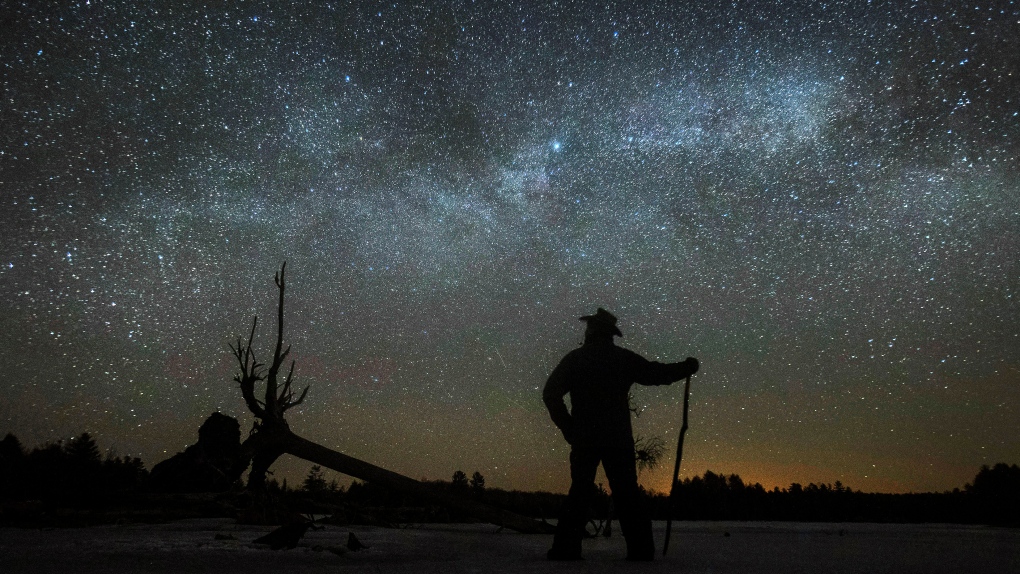
B.C. tenants evicted for landlord's use after refusing large rent increase to take over neighbouring suite
Ashley Dickey and her mother rented part of the same Coquitlam duplex in three different decades under three different landlords.
A mysterious elongated object is being dragged into the supermassive black hole at the centre of our galaxy, according to a new study.
Led by astronomers from the UCLA Galactic Center Group and Keck Observatory in Hawaii, the study is based on two decades of observations of the object, which is known as X7. Researchers now believe it could be a cloud of gas and dust ejected when two stars collided.
"No other object in this region has shown such an extreme evolution,” UCLA assistant researcher and lead author Anna Ciurlo said in a news release. "It started off comet-shaped and people thought maybe it got that shape from stellar winds or jets of particles from the black hole. But as we followed it for 20 years we saw it becoming more elongated. Something must have put this cloud on its particular path with its particular orientation."
Researchers expect X7 to make its closest approach to the black hole known as Sagittarius A* around the year 2036. After that, they predict, X7 will disintegrate and spiral towards the black hole at the centre of the Milky Way before disappearing.
“We anticipate the strong tidal forces exerted by the galactic black hole will ultimately tear X7 apart before it completes even one orbit,” co-author and UCLA professor of physics and astronomy Mark Morris said.
The study was published this week in The Astrophysical Journal.
Although X7's origin is still uncertain, the merger of stars can be common near black holes.
"This is a very messy process: The stars circle each other, get closer, merge, and the new star is hidden within a cloud of dust and gas," Ciurlo explained. "X7 could be the dust and gas ejected from a merged star that’s still out there somewhere."
X7 has a mass of about 50 Earths and is moving towards the black hole at a speed of approximately 1,125 kilometres per second. The researchers plan to continue observing X7 as the power of the supermassive black hole's gravity eventually tears it apart.
"It's exciting to see significant changes of X7’s shape and dynamics in such great detail over a relatively short time scale as the gravitational forces of the supermassive black hole at the center of the Milky Way influences this object," co-author and Keck Observatory science operations lead Randy Campbell said. "It's a privilege to be able to study the extreme environment at the center of our galaxy."

Ashley Dickey and her mother rented part of the same Coquitlam duplex in three different decades under three different landlords.
A man who fell into a crevasse while leading a backcountry ski group deep in the Canadian Rockies has died.
A new survey by Dalhousie University's Agri-Food Analytics Lab asked Canadians about their food consumption habits amid rising prices.
MPP Sarah Jama was asked to leave the Legislative Assembly of Ontario by House Speaker Ted Arnott on Thursday for wearing a keffiyeh, a garment which has been banned at Queen’s Park.
Charlie Woods failed to advance in a U.S. Open local qualifying event Thursday, shooting a 9-over 81 at Legacy Golf & Tennis Club.
As Donald Trump was running for president in 2016, his old friend at the National Enquirer was scooping up potentially damaging stories about the candidate and paying out tens of thousands of dollars to keep them from the public eye.
After Prime Minister Justin Trudeau said the federal government would still send Canada Carbon Rebate cheques to Saskatchewan residents, despite Saskatchewan Premier Scott Moe's decision to stop collecting the carbon tax on natural gas or home heating, questions were raised about whether other provinces would follow suit. CTV News reached out across the country and here's what we found out.
A Montreal actress, who has previously detailed incidents she had with disgraced Hollywood producer Harvey Weinstein, says a New York Court of Appeals decision overturning his 2020 rape conviction is 'discouraging' but not surprising.
Caleb Williams is heading to the Windy City, aiming to become the franchise quarterback Chicago has sought for decades.

Mounties in Nanaimo, B.C., say two late-night revellers are lucky their allegedly drunken antics weren't reported to police after security cameras captured the men trying to steal a heavy sign from a downtown business.
A property tax bill is perplexing a small townhouse community in Fergus, Ont.
When identical twin sisters Kim and Michelle Krezonoski were invited to compete against some of the world’s most elite female runners at last week’s Boston Marathon, they were in disbelief.
The giant stone statues guarding the Lions Gate Bridge have been dressed in custom Vancouver Canucks jerseys as the NHL playoffs get underway.
A local Oilers fan is hoping to see his team cut through the postseason, so he can cut his hair.
A family from Laval, Que. is looking for answers... and their father's body. He died on vacation in Cuba and authorities sent someone else's body back to Canada.
A former educational assistant is calling attention to the rising violence in Alberta's classrooms.
The federal government says its plan to increase taxes on capital gains is aimed at wealthy Canadians to achieve “tax fairness.”
At 6'8" and 350 pounds, there is nothing typical about UBC offensive lineman Giovanni Manu, who was born in Tonga and went to high school in Pitt Meadows.
 Stargazer Dave Cooke observes an unusual placement of the Milky Way, over a frozen fish sanctuary in central Ontario, north of Hwy 36 in Kawartha Lakes, Ont., on Sunday, March 21, 2021. (THE CANADIAN PRESS/Fred Thornhill)
Stargazer Dave Cooke observes an unusual placement of the Milky Way, over a frozen fish sanctuary in central Ontario, north of Hwy 36 in Kawartha Lakes, Ont., on Sunday, March 21, 2021. (THE CANADIAN PRESS/Fred Thornhill)